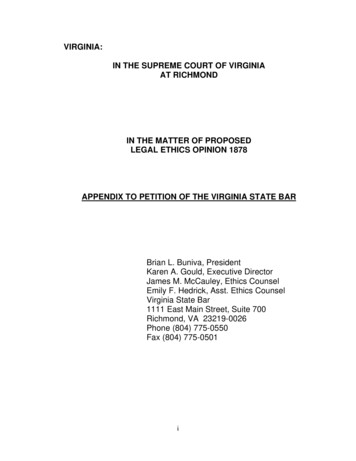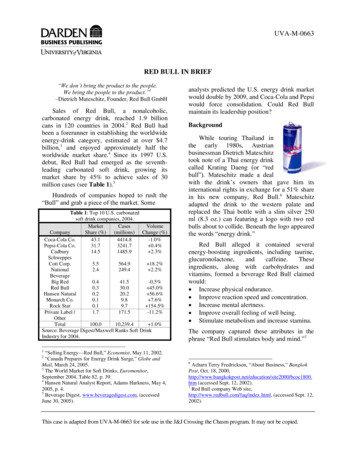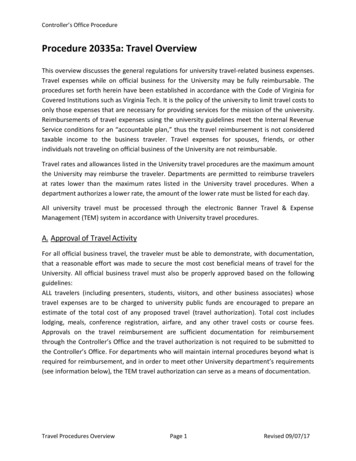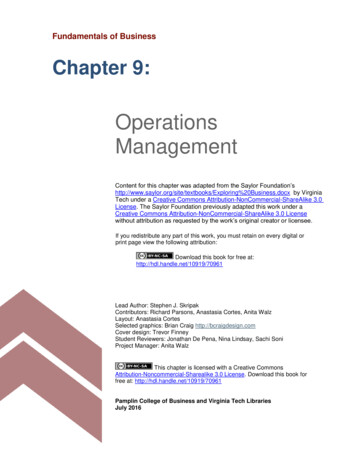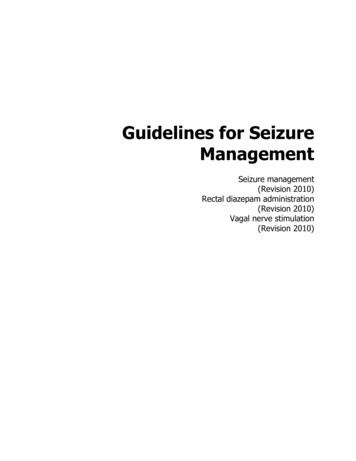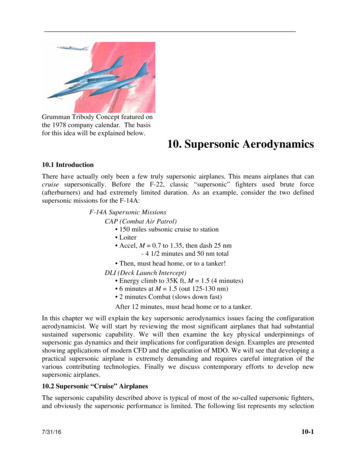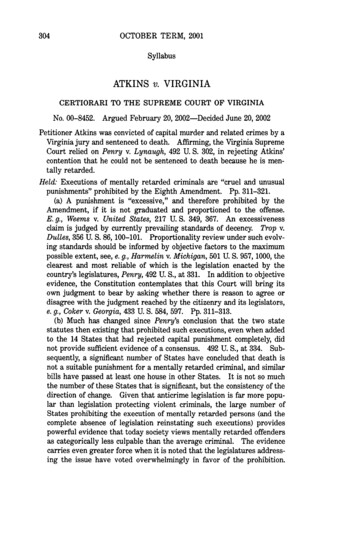
Transcription
OCTOBER TERM, 2001SyllabusATKINS v. VIRGINIACERTIORARI TO THE SUPREME COURT OF VIRGINIANo. 00-8452. Argued February 20, 2002-Decided June 20, 2002Petitioner Atkins was convicted of capital murder and related crimes by aVirginia jury and sentenced to death. Affirming, the Virginia SupremeCourt relied on Penry v. Lynaugh, 492 U. S. 302, in rejecting Atkins'contention that he could not be sentenced to death because he is mentally retarded.Held: Executions of mentally retarded criminals are "cruel and unusualpunishments" prohibited by the Eighth Amendment. Pp. 311-321.(a) A punishment is "excessive," and therefore prohibited by theAmendment, if it is not graduated and proportioned to the offense.E. g., Weems v. United States, 217 U. S. 349, 367. An excessivenessclaim is judged by currently prevailing standards of decency. Trop v.Dulles, 356 U. S. 86, 100-101. Proportionality review under such evolving standards should be informed by objective factors to the maximumpossible extent, see, e. g., Harmelinv. Michigan, 501 U. S. 957, 1000, theclearest and most reliable of which is the legislation enacted by thecountry's legislatures, Penry, 492 U. S., at 331. In addition to objectiveevidence, the Constitution contemplates that this Court will bring itsown judgment to bear by asking whether there is reason to agree ordisagree with the judgment reached by the citizenry and its legislators,e. g., Coker v. Georgia, 433 U. S. 584, 597. Pp. 311-313.(b) Much has changed since Penry's conclusion that the two statestatutes then existing that prohibited such executions, even when addedto the 14 States that had rejected capital punishment completely, didnot provide sufficient evidence of a consensus. 492 U. S., at 334. Subsequently, a significant number of States have concluded that death isnot a suitable punishment for a mentally retarded criminal, and similarbills have passed at least one house in other States. It is not so muchthe number of these States that is significant, but the consistency of thedirection of change. Given that anticrime legislation is far more popular than legislation protecting violent criminals, the large number ofStates prohibiting the execution of mentally retarded persons (and thecomplete absence of legislation reinstating such executions) providespowerful evidence that today society views mentally retarded offendersas categorically less culpable than the average criminal. The evidencecarries even greater force when it is noted that the legislatures addressing the issue have voted overwhelmingly in favor of the prohibition.
Cite as: 536 U. S. 304 (2002)SyllabusMoreover, even in States allowing the execution of mentally retardedoffenders, the practice is uncommon. Pp. 313-317.(c) An independent evaluation of the issue reveals no reason for theCourt to disagree with the legislative consensus. Clinical definitions ofmental retardation require not only subaverage intellectual functioning,but also significant limitations in adaptive skills. Mentally retardedpersons frequently know the difference between right and wrong andare competent to stand trial, but, by definition, they have diminishedcapacities to understand and process information, to communicate, toabstract from mistakes and learn from experience, to engage in logicalreasoning, to control impulses, and to understand others' reactions.Their deficiencies do not warrant an exemption from criminal sanctions,but diminish their personal culpability. In light of these deficiencies,the Court's death penalty jurisprudence provides two reasons to agreewith the legislative consensus. First, there is a serious questionwhether either justification underpinning the death penalty-retribution and deterrence of capital crimes-applies to mentally retarded offenders. As to retribution, the severity of the appropriate punishmentnecessarily depends on the offender's culpability. If the culpability ofthe average murderer is insufficient to justify imposition of death, seeGodfrey v. Georgia, 446 U. S. 420, 433, the lesser culpability of the mentally retarded offender surely does not merit that form of retribution.As to deterrence, the same cognitive and behavioral impairments thatmake mentally retarded defendants less morally culpable also make itless likely that they can process the information of the possibility ofexecution as a penalty and, as a result, control their conduct based uponthat information. Nor will exempting the mentally retarded from execution lessen the death penalty's deterrent effect with respect to offenders who are not mentally retarded. Second, mentally retarded defendants in the aggregate face a special risk of wrongful execution becauseof the possibility that they will unwittingly confess to crimes they didnot commit, their lesser ability to give their counsel meaningful assistance, and the facts that they are typically poor witnesses and that theirdemeanor may create an unwarranted impression of lack of remorse fortheir crimes. Pp. 317-l21.260 Va. 375, 534 S. E. 2d 312, reversed and remanded.STEVENS, J., delivered the opinion of the Court,KENNEDY, SOUTER, GINSBURG, and BREYER, JJ.,in which O'CONNOR,joined. REHNQUIST,C. J., filed a dissenting opinion, in which SCALIA and THOMAS, JJ., joined,post, p. 321. SCALIA, J., filed a dissenting opinion, in which REHNQUIST,C. J., and THOMAS, J., joined, post, p. 337.
ATKINS v. VIRGINIAOpinion of the CourtJames W Ellis argued the cause for petitioner. With himon the briefs were Robert E. Lee, by appointment of theCourt, 534 U. S. 1122, Mark E. Olive, and Charles E. Haden.Pamela A. Rumpz, Assistant Attorney General of Virginia, argued the cause for respondent. With her on thebrief was Randolph A. Beales, Attorney General.*delivered the opinion of the Court.Those mentally retarded persons who meet the law's requirements for criminal responsibility should be tried andpunished when they commit crimes. Because of their disabilities in areas of reasoning, judgment, and control of theirimpulses, however, they do not act with the level of moralculpability that characterizes the most serious adult criminalconduct. Moreover, their impairments can jeopardize theJUSTICE STEVENS*Briefs of amici curiae urging affirmance were filed for the State ofAlabama et al. by Bill Pryor, Attorney General of Alabama, and J Clayton Crenshaw,Henry M. Johnson,James R. Houts, A. Vernon Barnett IV,Michael B. Billingsley, and David R. Clark, Assistant Attorneys General,Michael C. Moore, Attorney General of Mississippi, Frankie Sue DelPapa,Attorney General of Nevada, Charles M. Condon, Attorney Generalof South Carolina, and Mark L. Shurtleff, Attorney General of Utah; andfor the Criminal Justice Legal Foundation by Kent S. Scheidegger andCharles L. Hobson.[REPORTER'S NOTE: On December 3, 2001, 534 U. S. 1053, the Courtgranted the motion of amici curiae filers in McCarver v. North Carolina,No. 00-8727, cert. dism'd, 533 U. S. 975, to have their amici curiae briefsconsidered in support of petitioner in this case. Such briefs were filed forthe American Association on Mental Retardation et al. by James W Ellis,April Land, Christian G. Fritz, Michael B. Browde, and Stanley S. Herr;for the American Bar Association by Martha W Barnett and David M.Gossett; for the American Civil Liberties Union et al. by Larry W Yackle,Bryan A. Stevenson, Steven R. Shapiro, and Diann Y Rust-Tierney; forthe American Psychological Association et al. by Paul M. Smith, WilliamM. Hohengarten,Nathalie F. P. Gilfoyle, James L. McHugh, and RichardG. Taranto;for the European Union by RichardJ. Wilson; for the UnitedStates Catholic Conference et al. by Mark E. Chopko, Jeffrey HunterMoon, and Michael R. Moses; and for Morton Abramowitz et al. by HaroldHongju Koh and Stanley S. Herr.]
Cite as: 536 U. S. 304 (2002)Opinion of the Courtreliability and fairness of capital proceedings against mentally retarded defendants. Presumably for these reasons, inthe 13 years since we decided Penry v. Lynaugh, 492 U. S.302 (1989), the American public, legislators, scholars, andjudges have deliberated over the question whether the deathpenalty should ever be imposed on a mentally retarded criminal. The consensus reflected in those deliberations informsour answer to the question presented by this case: whethersuch executions are "cruel and unusual punishments" prohibited by the Eighth Amendment to the Federal Constitution.IPetitioner, Daryl Renard Atkins, was convicted of abduction, armed robbery, and capital murder, and sentenced todeath. At approximately midnight on August 16, 1996, Atkins and William Jones, armed with a semiautomatic handgun, abducted Eric Nesbitt, robbed him of the money on hisperson, drove him to an automated teller machine in hispickup truck where cameras recorded their withdrawal ofadditional cash, then took him to an isolated location wherehe was shot eight times and killed.Jones and Atkins both testified in the guilt phase of Atkins' trial.1 Each confirmed most of the details in the other's account of the incident, with the important exceptionthat each stated that the other had actually shot and killedNesbitt. Jones' testimony, which was both more coherentand credible than Atkins', was obviously credited by the juryand was sufficient to establish Atkins' guilt. 2 At the penaltyIInitially, both Jones and Atkins were indicted for capital murder. Theprosecution ultimately permitted Jones to plead guilty to first-degree murder in exchange for his testimony against Atkins. As a result of the plea,Jones became ineligible to receive the death penalty.2 Highly damaging to the credibility of Atkins' testimony was its substantial inconsistency with the statement he gave to the police upon hisarrest. Jones, in contrast, had declined to make an initial statement tothe authorities.
ATKINS v. VIRGINIAOpinion of the Courtphase of the trial, the State introduced victim impact evidence and proved two aggravating circumstances: futuredangerousness and "vileness of the offense." To prove future dangerousness, the State relied on Atkins' prior felonyconvictions as well as the testimony of four victims of earlierrobberies and assaults. To prove the second aggravator, theprosecution relied upon the trial record, including picturesof the deceased's body and the autopsy report.In the penalty phase, the defense relied on one witness,Dr. Evan Nelson, a forensic psychologist who had evaluatedAtkins before trial and concluded that he was "mildly mentally retarded."His conclusion was based on interviewswith people who knew Atkins,4 a review of school and courtIThe American Association on Mental Retardation (AAMR) definesmental retardation as follows: "Mental retardationrefers to substantiallimitations in present functioning. It is characterized by significantlysubaverage intellectual functioning, existing concurrently with relatedlimitations in two or more of the following applicable adaptive skill areas:communication, self-care, home living, social skills, community use, selfdirection, health and safety, functional academics, leisure, and work.Mental retardation manifests before age 18." Mental Retardation: Definition, Classification, and Systems of Supports 5 (9th ed. 1992).The American Psychiatric Association's definition is similar: "The essential feature of Mental Retardation is significantly subaverage generalintellectual functioning (Criterion A) that is accompanied by significantlimitations in adaptive functioning in at least two of the followingskill areas: communication, self-care, home living, social/interpersonalskills, use of community resources, self-direction, functional academicskills, work, leisure, health, and safety (Criterion B). The onset mustoccur before age 18 years (Criterion C). Mental Retardation has manydifferent etiologies and may be seen as a final common pathway of various pathological processes that affect the functioning of the centralnervous system." Diagnostic and Statistical Manual of Mental Disorders 41 (4th ed. 2000). "Mild" mental retardation is typically used todescribe people with an IQ level of 50-55 to approximately 70. Id., at42-43.4 The doctor interviewed Atkins, members of his family, and deputiesat the jail where he had been incarcerated for the preceding 18 months.Dr. Nelson also reviewed the statements that Atkins had given to thepolice and the investigative reports concerning this case.
Cite as: 536 U. S. 304 (2002)Opinion of the Courtrecords, and the administration of a standard intelligencetest which indicated that Atkins had a full scale IQ of 59. 5The jury sentenced Atkins to death, but the Virginia Supreme Court ordered a second sentencing hearing becausethe trial court had used a misleading verdict form. 257 Va.160, 510 S. E. 2d 445 (1999). At the resentencing, Dr. Nelsonagain testified. The State presented an expert rebuttal witness, Dr. Stanton Samenow, who expressed the opinion thatAtkins was not mentally retarded, but rather was of "average intelligence, at least," and diagnosable as having antisocial personality disorder.6 App. 476. The jury again sentenced Atkins to death.5Dr. Nelson administered the Wechsler Adult Intelligence Scales test(WAIS-III), the standard instrument in the United States for assessing intellectual functioning. AAMR, Mental Retardation, supra. TheWAIS-III is scored by adding together the number of points earned ondifferent subtests, and using a mathematical formula to convert this rawscore into a scaled score. The test measures an intelligence range from45 to 155. The mean score of the test is 100, which means that a personreceiving a score of 100 is considered to have an average level of cognitivefunctioning. A. Kaufman & E. Lichtenberger, Essentials of WAIS-IIIAssessment 60 (1999). It is estimated that between 1 and 3 percent ofthe population has an IQ between 70 and 75 or lower, which is typicallyconsidered the cutoff IQ score for the intellectual function prong of themental retardation definition. 2 Kaplan
Michael B. Billingsley, and David R. Clark, Assistant Attorneys General, Michael C. Moore, Attorney General of Mississippi, Frankie Sue Del Papa, Attorney General of Nevada, Charles M. Condon, Attorney General of South Carolina, and Mark L. Shurtleff, Attorney General of Utah; and for the Criminal Justice Legal Foundation by Kent S. Scheidegger and Charles L. Hobson. [REPORTER'S


